We journeyed to Garryowen, MT. yesterday which is the closest town to the Battle of the Little Big Horn Battlefield NM, and into the only campground near it: the 7th Ranch. Nice campground but the 1-mile gravel road into the campground sure did a number on our clean RV - and our clean Jeep. Oh, well. We set up, enjoyed the beautiful day, had dinner and relaxed. We planned to visit the NM tomorrow.
(So how in the world a town got the name of Garry Owen? Actually, it’s not a person’s name but a loose translation of the Gaelic meaning ‘Owen’s Garden.’ About 40% of Custer’s regiments were foreign-born with the majority of these from Ireland and England. One of the songs that the Irish sang was a song called Garry Owen and Custer liked it so much that he took it as his regiment’s song to build company morale and spirit. )
We’ve all heard of Custer’s Last Stand between the army forces led by General George Armstrong Custer and the Native American forces led by Chief Sitting Bull and Crazy Horse. Well, it used to be called Custer’s Last Stand but in 1991 the US Congress changed the name of the battlefield to the Little Bighorn Battlefield National Monument. and ordered the construction of an Indian Memorial. The new name more correctly reflects that it really was a battle between Americans and Americans. And, that is certainly how the National Park Service presents it. Actually, it wasn’t just a battle between two opposing military forces but between two opposing ways of life and beliefs. On one side was the commercial, industrial, agricultural, based culture of the US and the hunting, gathering, nomadic culture of the Native American. Even though the Native Americans won a few battles along the way, with the Little Big Horn being one of them, the war was won by the US.
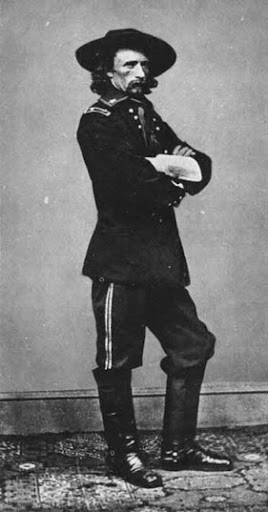
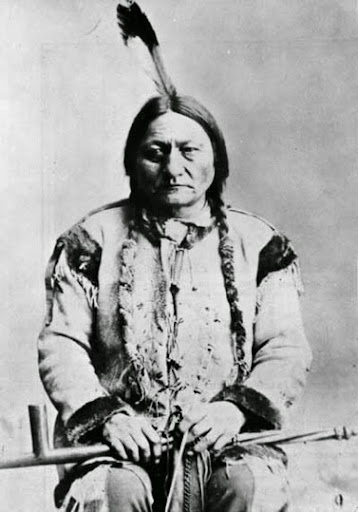
The confrontations between these two groups had been going on since the first Europeans landed in America but really took off after the Civil War when thousands of settlers left the east coast heading west in the search for land and gold. Confrontations ensued until 1868 when the US government and the Sioux along with other Great Plains tribes signed a treaty giving to the Sioux a large section of the upper Great Plains, including the Black Hills, as a reservation and the US government agreed to protect the tribes ‘against the commission of all depredations by people of the US.’
2 problems: first many of the Indians, including Crazy Horse and Sitting Bull, did not want to give up their nomadic way of life and accept the reservation system. They felt no obligation to stay on the reservation and continued to roam and hunt. Secondly, gold was discovered in the Black Hills of South Dakota in 1874. Though the US government tried to keep all the hordes of eager gold seekers out, it was difficult and thousands found their way in to begin their mines. The Sioux and Cheyenne refused President Grant’s offer to buy the land especially since the Sioux considered this sacred land. When many of the Indians, led by Sitting Bull, began to raid settlements on the fringes of their territory, President Grant sent the army began a campaign to force them back to the reservation.
To the Indians, the cause of the wars was the continual encroachment on their lands by the settlers, miners, soldiers and others often in violation of the treaties signed by the US Government. To the whites, the continual raids by the Indians upon their homes and settlements and their refusal to reside on the reservations was the cause of the wars.
The campaign included 3 separate groups to capture the Indians in a pincer movement. General George Armstrong Custer and the 600-man 7th cavalry was part of one of these groups and sent to the Little Big Horn from the south. Custer’s scouts, from the Crow and Arikara tribes, and had their own conflicts with the Sioux, spotted the Sioux Village over a hill, galloped back to tell Custer who then ordered his forces to split in three and attack. However, by this time the Sioux, who greatly outnumbered Custer with 1500 - 1800 warriors, had spotted his troops and the element of surprise was lost. He split his group into thirds and began the attack.
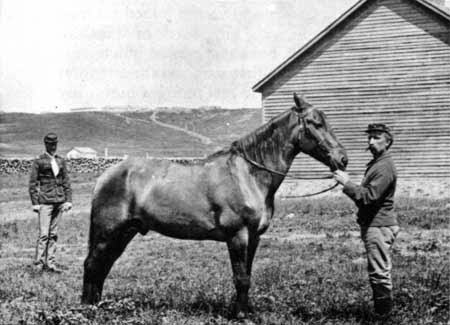
Comanche, "the only living thing found on Custer Battlefield." This photograph was taken at Fort Lincoln, 1877, about 1 year after the battle. Blacksmith Korn is holding the bridle and Capt. H. J. Nowlan, Seventh Cavalry, is in the background.
(Photograph by courtesy Haynes, Inc.. Yellowstone National Park, Wyo.)
Outnumbered 3-1, they came under heavy attack, were forced back and Custer found himself and his command on a hill surrounded by Indians led by Crazy Horse. They shot their horses to use them for cover but it was not enough and all 209 in his command were killed on the hill in less than an hour.
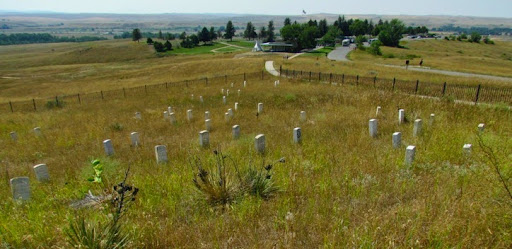
The other two groups united and fought their own battle about 3.5 miles away. 2 days later, the Indians left, knowing that other soldiers were heading their way, taking their dead and wounded with them. The tribes and families then scattered, each going their own way. Eventually, they returned to the reservations and surrendered.
The Indians won that particular battle but lost the war. The deaths of Custer and his men caused outrage in the US and not only did Grant send more troops but the US also redrew the reservation borders so as not to include the Black Hills. That’s a very short summary of the battle and its causes and results. Obviously thousands of books have been written about it and many are still being written. They are actually still making archaeological discoveries in the area and studying it thoroughly.
To get more out of our visit, we took the short walking tour around the area and really enjoyed it and learned a lot. The Ranger who was giving the tour is head of a university art department and has written what is usually called a coffee-table book on mapping the battle. He lives and teaches in Texas during the winter but journeys up to Montana both to study and to work as a Ranger during the summer. He told us that he had written a book on the battle and I cruised through the book store in the VC, reading author’s names but couldn’t find his name at all. Later, back at the RV, I checked Amazon and found his book. It looks very interesting, especially since I love maps, but I can see why it is not for sale in the bookstore.

After his tour, we walked around the area ourselves to revisit the things he had talked about. We circled around the Indian Memorial first. Here’s a sculpture on one side.
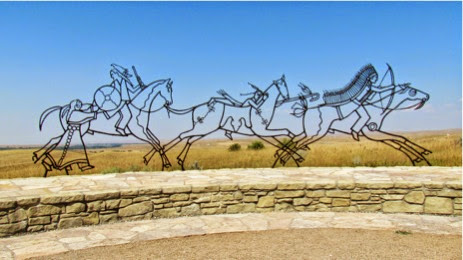
And, here’s a painting of one of the Cheyenne warriors. This was done with a small Dremel tool - hard to believe since it’s so detailed.
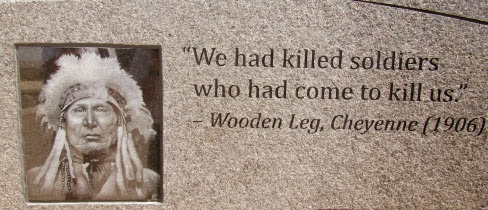
The Indian Monument was designed with this on one of the sides: a slot in which the soldiers’ monument is directly in the middle - so the souls of the soldiers and the souls of the Indians can meet in the middle.
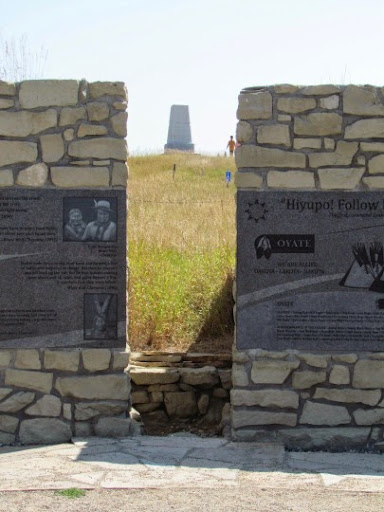
The Ranger told us that there were probably not two men buried here. Firstly there are more tombstones than there were men who died. Secondly He told us that when the rest of Custer’s command came to bury the bodies, they were hurried because they feared the return of the Indians. Also the ground was extremely hard and they had few tools. Thus, the theory is that they had a body on the ground and dug around it on both sides and covered the body that way. Over the years scavengers had taken care of the bodies and when the army returned to bury the bodies officially, they found no bodies but did find the two depressions on each side and assumed that there had been two bodies, one for each depression. Thus, in many places there are two tombstones placed side by side.
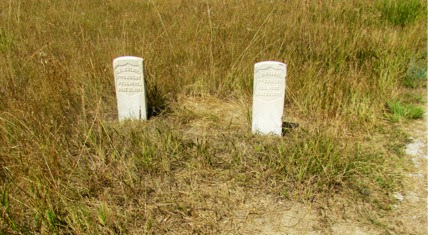
He also told us that they buried the officers with their names but the ordinary enlisted man was just called a soldier on their stones.
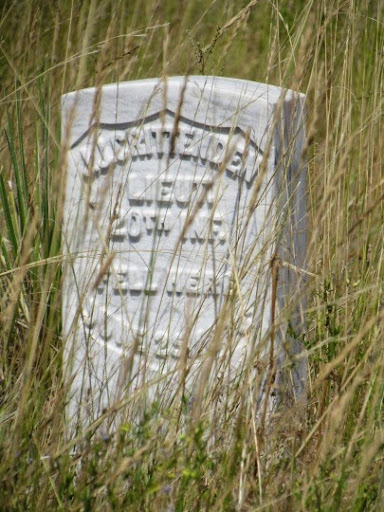
In 1991, stones for the Indians who died in the battle were placed around the battlefield. Since the families had taken their bodies after the battle, it’s not known exactly where they fell but they were put in the most logical position.
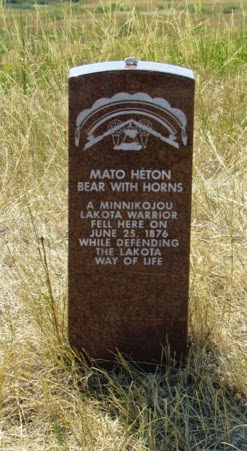
After this we went to another description of the actual battle it self, minute by minute by another Ranger. My, he really got into his subject. He shouted ‘pow’, ‘pow’ when he wanted us to know guns had been shot, he yelled ‘pack trains, pack trains’, when he was telling how Custer wanted the pack trains with the ammo, he shouted ‘whoosh’ when he wanted us to know that arrows had been shot. He made it all so very real. His talk was about 45 minutes long and, while we visitors were under some shade on chairs, he was out in the sun giving us his all. He was spent when he finished.
We then toured the museum there and then, since we wanted to take our walk, we walked the road towards more of the battle field. There are red stones and white stones strewn throughout the battlefield.

One of the things that surprised us about the Battle was that there were lots of Indians who were helping Custer. These tribes also had problems with the Sioux who were a fiercer tribe than many others and also claimed some land that belonged to other tribes. At the monument where the Indians have erected their own monument to celebrate their warriors, they celebrate both sides: the Lakota Sioux and Cheyenne and the Crow and Arikara tribes.
Very neat monument and marvelous talks by the Rangers.

No comments:
Post a Comment